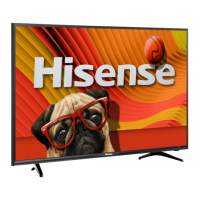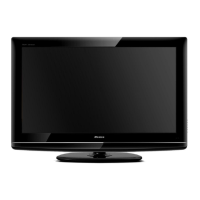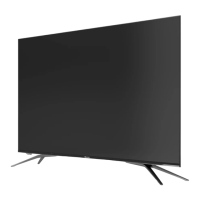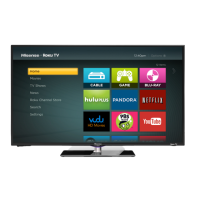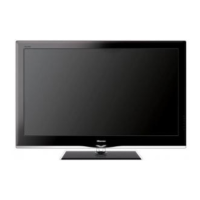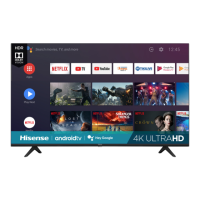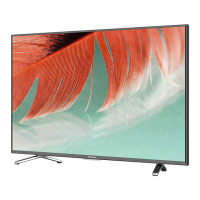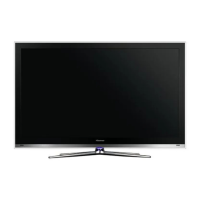Do you have a question about the Hisense HE32N50HTS and is the answer not in the manual?
Guide contains menus, settings, and functions; refer to quick setup for installation.
Precautions to avoid dangerous situations and damage to the unit.
Guidelines for safely moving and handling the TV unit to prevent damage.
Instructions for safe connection and use of the power supply and cable.
Ensure proper airflow and avoid high temperatures to prevent component failure.
Guidelines for secure stand attachment and child safety during installation.
Warnings about LED screen care, image burn, and radio wave interference.
Actions to take during thunderstorms and periods of non-use.
Guidelines for cleaning, repair, modification, and battery handling.
How to change channels, select picture modes, and aspect ratios.
Using sleep timer, audio options, channel list, and EPG.
Instructions for connecting aerial, HDMI, USB, digital audio, and headphones.
Step-by-step guide for the initial setup and configuration of the TV.
Detailed steps for Auto Tuning and Manual Tuning within the Channel menu.
How to edit channels, view signal strength, and quality.
Selecting picture modes and adjusting contrast, brightness, color, tint, and sharpness.
Adjusting color temperature and noise reduction for optimal picture quality.
Choosing from various sound modes like Standard, Music, Movie, and Sports.
Adjusting balance, auto volume level, and audio delay settings.
Setting the correct time zone and managing the clock display.
Configuring sleep timer for auto-off and OSD timer for display duration.
Enabling system lock and setting a password for security.
Locking specific channels and setting parental controls based on age.
Configuring OSD language, Teletext language, and audio/subtitle languages.
Adjusting aspect ratio and controlling the blue screen display.
Updating software via USB and managing HDMI CEC features.
Viewing photos from a USB device via the Photo menu.
Playing music files from a USB device.
Playing movie files from a USB device.
Accessing and displaying text-based content from a USB device.
Solutions for issues with sound, picture, or remote control operation.
Diagnosing and fixing distorted images, wavy pictures, or sound problems.
Details on colour system, television system, and environmental operating conditions.
List of playable media files, codecs, and their specifications.
Guidelines for proper disposal of electronic waste and batteries.
Details on the Restriction of Hazardous Substances directive.
Guide contains menus, settings, and functions; refer to quick setup for installation.
Precautions to avoid dangerous situations and damage to the unit.
Guidelines for safely moving and handling the TV unit to prevent damage.
Instructions for safe connection and use of the power supply and cable.
Ensure proper airflow and avoid high temperatures to prevent component failure.
Guidelines for secure stand attachment and child safety during installation.
Warnings about LED screen care, image burn, and radio wave interference.
Actions to take during thunderstorms and periods of non-use.
Guidelines for cleaning, repair, modification, and battery handling.
How to change channels, select picture modes, and aspect ratios.
Using sleep timer, audio options, channel list, and EPG.
Instructions for connecting aerial, HDMI, USB, digital audio, and headphones.
Step-by-step guide for the initial setup and configuration of the TV.
Detailed steps for Auto Tuning and Manual Tuning within the Channel menu.
How to edit channels, view signal strength, and quality.
Selecting picture modes and adjusting contrast, brightness, color, tint, and sharpness.
Adjusting color temperature and noise reduction for optimal picture quality.
Choosing from various sound modes like Standard, Music, Movie, and Sports.
Adjusting balance, auto volume level, and audio delay settings.
Setting the correct time zone and managing the clock display.
Configuring sleep timer for auto-off and OSD timer for display duration.
Enabling system lock and setting a password for security.
Locking specific channels and setting parental controls based on age.
Configuring OSD language, Teletext language, and audio/subtitle languages.
Adjusting aspect ratio and controlling the blue screen display.
Updating software via USB and managing HDMI CEC features.
Viewing photos from a USB device via the Photo menu.
Playing music files from a USB device.
Playing movie files from a USB device.
Accessing and displaying text-based content from a USB device.
Solutions for issues with sound, picture, or remote control operation.
Diagnosing and fixing distorted images, wavy pictures, or sound problems.
Details on colour system, television system, and environmental operating conditions.
List of playable media files, codecs, and their specifications.
Guidelines for proper disposal of electronic waste and batteries.
Details on the Restriction of Hazardous Substances directive.
| Screen Size | 32 inches |
|---|---|
| Resolution | 1366 x 768 |
| Display Technology | LED |
| Smart TV | Yes |
| HDMI Ports | 2 |
| USB Ports | 1 |
| Wi-Fi | Yes |
| Refresh Rate | 60Hz |
| Dimensions (W x H x D) | 730 x 430 x 80 mm |
